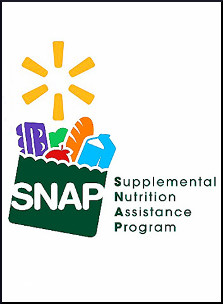
A government website enumerates the SNAP (Food Stamp) Program rights of people experiencing homelessness.(“Food Support” is the term some states use, and others have their own individual monikers like Wisconsin’s FoodShare, Vermont’s 3SquaresVT, and of course CalFresh.) We are told that homeless persons have even more rights than the housed, because they don’t need to give a permanent address to apply. (In the realm of extra-fancy privileges, that one is underwhelming.) Besides, we keep hearing that homeless applicants still need to give a mailing address, even if it is as ephemeral as a drop-in center.
In order to receive SNAP benefits, a person doesn’t need a place to cook or store food (although it sure helps). And even those who live in shelters where meals are served are eligible. While sources seem to agree that $200 per month is the largest SNAP benefit that an individual might be eligible for, information on the standard amount is confusing. One website says that in 2014, the average benefit was $125 per month, and another says that in 2015, the average was $194 per month, which is more, and that seems odd because as time progresses, these payments are constantly cut. (Even the higher number, however, amounts to less than $7 a day.) An online commenter called Goth Farmer states that a homeless person receives $189 per month.
Currently, people fortunate enough to have Section 8 housing are shocked into awareness that a break on the rent is considered to be quite enough in the way of help, because their SNAP allowance is now under $20 a month. This is a stern reminder that SNAP stands for Supplemental Nutrition Assistance Program. In other words, food stamps are not meant to sustain life, merely to complement the acquisition of food by (chiefly) other means.
For people experiencing homelessness, this brings up issues that even the best-intentioned humanitarians disagree on. Should a shelter or a soup kitchen charge the people who eat there by taking part of their Electric Benefit Transfer funds? Well, yes, because the facility needs help acquiring the food, and it might not even be able to stay open if not for these contributions.
As for the diners, people attain dignity by paying for the things they consume. But on the other hand, after the soup kitchen meal is over, they will need other meals on other days, and their “food stamps.” There is no guarantee of finding a free meal on any given day, and the rules page says, “They cannot force you… to pay for food at the shelter. They can only request that you voluntarily use your SNAP/Food Stamps to pay for meals.”
The SNAP Situation Is About to Get Worse
No matter how bad things are, they are about to get worse for about a million unemployed childless adults, many of whom are either homeless or at risk of becoming so. Members of this demographic typically receive between $150 and $200 per month, according to Ed Bolen, writing for the Center on Budget and Policy Priorities. After this year, it will be tougher to qualify. The rule was already on the books, with each state having the option to petition for a waiver—which many have been doing. In 2016, it appears that almost no states plan to apply for renewal of that waiver. Bolen explains:
Even SNAP recipients whose state operates few or no employment programs for them and fails to offer them a spot in a work or training program—which is the case in most states—have their benefits cut off after three months irrespective of whether they are searching diligently for a job… This leaves it up to individuals who can’t find a job to try to find training or work program openings on their own, which few are able to do, especially since most training programs have insufficient resources to meet demand, resulting in substantial waiting lists.
Getting back to Goth Farmer, he (or she) says:
There you have a massive flaw in the idea all homeless always have the option of SNAP for food. Then, you have the identity issue. You have to prove identity to qualify and fact is many homeless can’t. They have no proof of who they are. No photo ID, no SS card, not birth cert. or voter card. Many homeless are underage and avoid any contact with any agency or shelter due to fear of being returned to what they ran from… The mentally ill are often not capable of far simpler tasks then wading through a ream of paperwork to get SNAP.
So, things are seldom as simple as they appear, and sufficient nourishment is still a problem for many Americans.
Reactions?
Source: “Homeless Persons’ Rights under the SNAP/Food Stamp Program,” frac.org, undated
Source: “Policy Basics: Introduction to the Supplemental Nutrition Assistance Program (SNAP),” CBPP.com, undated
Source: “”Supplemental Nutrition Assistance Program (SNAP),” USDA.gov
Source: “Approximately 1 Million Unemployed Childless Adults Will Lose SNAP Benefits in 2016 as State Waivers Expire,” CBPP.org, 01/05/15
Image by U.S. Government


